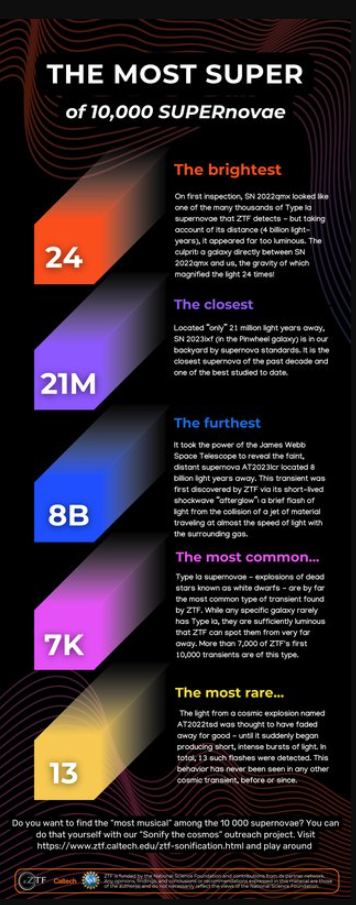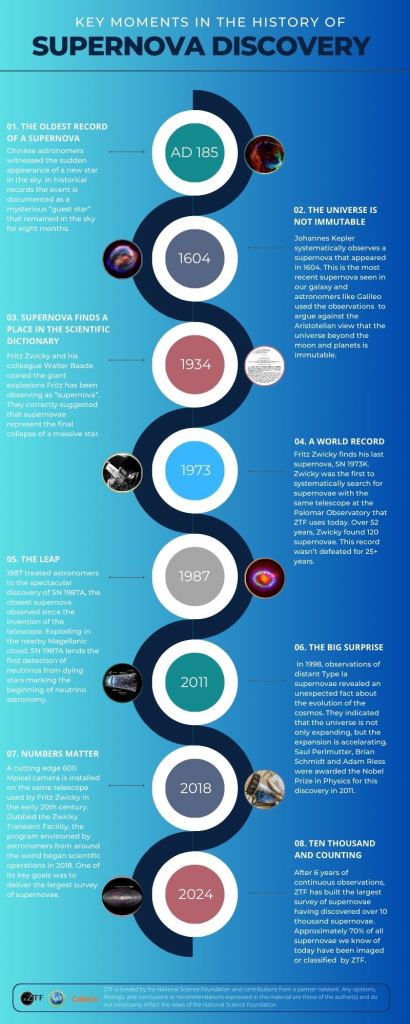Even if you knew nothing about astronomy, you’d understand that exploding stars are forceful and consequential events. How could they not be? Supernovae play a pivotal role in the Universe with their energetic, destructive demises.
There are different types of supernovae exploding throughout the Universe, with different progenitors and different remnants. The Zwicky Transient Facility has detected 100,000 supernovae and classified 10,000 of them.
The Zwicky Transient Facility (ZTF) is a wide-field astronomical survey named after the prolific Swiss astronomer Fritz Zwicky. In the early 1930s, Zwicky and his colleague Walter Baade coined the term ‘supernova’ to describe the transition of normal main sequence stars into neutron stars. In the 1940s, Zwicky and his colleague developed the modern supernova classification system. The ZTF bears his name because of these and many other scientific contributions. (Zwicky was also a humanitarian and a philosopher.)
The ZTF observes in both optical and infrared and was built to detect transients with the Samuel Oschin Telescope at the Palomar Observatory in San Diego County, California. Transients are objects that change brightness rapidly or objects that move. While supernovae (SN) don’t move, they definitely change brightness rapidly. They can outshine their entire host galaxy for months.
In 2017, the ZTF began its Bright Transient Survey (BTS), an effort dedicated to the search for supernovae (SNe). It’s by far the largest spectroscopic SNe survey ever conducted. The BTS has discovered 100,000 potential SNe, and more than 10,000 of them have been confirmed and classified according to distance, type, rarity, and brightness. These types of astronomical surveys create a rich dataset that will aid researchers well into the future.
“There are trillions of stars in the universe, and about every second, one of them explodes. Reaching 10,000 classifications is amazing, but what we truly should celebrate is the incredible progress we have made in our ability to browse the universe for transients, or objects that change in the sky, and the science our rich data will enable,” said Christoffer Fremling, a staff astronomer at Caltech. Fremling leads the ZTF’s Bright Transient Survey (BTS).
The effort to catalogue supernovae dates back to 2012 when astronomical databases began officially tracking them. Since then, astronomers have detected nearly 16,000 of them, and the ZTF is responsible for more than 10,000 of those detections.
The first documented SNe discovery was in 185 AD when Chinese astronomers recorded the appearance of a ‘guest star’ in the sky that shone for eight months. In the nearly two millennia since then, we’ve seen many more. 1987 was a watershed year for supernovae science when a massive star exploded in the nearby Large Magellanic Cloud. Named SN 1987A. it was the first supernova explosion since the telescope was invented. This was also the first direct detection of neutrinos from a supernova, and the detection is considered by many to be the beginning of neutrino astronomy.
Each night, the ZTF detects hundreds of thousands of events, including everything from small, simple asteroids in our inner Solar System to powerful gamma-ray bursts in the distant Universe. The ZTF uses a pair of telescopes that act as a kind of ‘triage’ facility for supernovae and transients. The Samuel Oschin Telescope has a 60-megapixel wide field camera that images the visible sky every two nights. Astronomers detect new transient events by subtracting images of the same portion of the sky from subsequent scans.
Then, members of the ZTF team study these images and send the most promising to the other ZTF telescope, the Spectral Energy Distribution Machine (SEDM). This robotic spectrograph operates on the Palomar 60-inch telescope.
“We combine the brightness information from the ZTF camera with the data from the SEDM to correctly identify the origin and type of a transient, a process astronomers call transient classification,” said Yu-Jing Qin, a postdoc at Caltech, who is running much of the daily operations of the BTS survey.
ZTF Detections are also sent to other observatories around the world who can examine transients with other spectroscopic facilities. About 30% of the ZTF transients have been confirmed this way.
ZTF detects so many transients that it’s difficult for astronomers to keep up. In recent years, Caltech has made an effort to develop machine-learning tools that can examine SEDM spectroscopic data, classify the transients, and send them to the Transient Name Server. In 2023, the BTSBot system was employed to help manage the flow of detections.
“Since BTSbot began operation it has found about half of the brightest ZTF supernovae before a human,” said PhD student Nabeel Rehemtulla from Northwestern University, developer of the BTSBot. “For specific types of supernovae, we have automated the entire process and BTSbot has so far performed excellently in over a hundred cases. This is the future of supernova surveys, especially when the Vera Rubin Observatory begins operations.”
Though every supernova discovery is scientifically valuable, there are some highlights among all these detections.
The ZTF has detected thousands of Type 1a supernovae. They occur in binary systems where one star is a white dwarf. The white dwarf draws gas away from its companion and the gas gathers on the white dwarf. Eventually, this causes a supernova explosion. SN 2022qmx is one of these Type 1a supernovae that appeared to be way brighter than it should be. It turns out that an interceding galaxy was gravitationally lensing the SN’s light, making it appear 24 times brighter.
The ZTF is also responsible for detecting the closest and most distant SNe (with help from the JWST).

“Back when we started this project, we didn’t know how many astronomers would follow up on our detections,” said Caltech’s Fremling. “To see that so many have is a testament to why we built ZTF: to survey the whole sky for changing objects and share those data as rapidly as possible with astronomers around the world. That’s the purpose of the Transient Name Server (TNS).”
The TNS is where the global astronomical community announces the detection and classification of transients so that work isn’t duplicated. Since 2016, the TNS has handled over 150,000 reported transients and over 15,000 reported supernovae.
“Everything is public in hopes that the community will come together and make the most of it,” said Fremling. “This way, we don’t have, say, 10 telescopes across the world doing the same thing and wasting time.”
Soon, the ZTF will have a powerful partner in time-domain astronomy. The Vera Rubin Observatory (VRO) should see its first light in the next few months and then begin its 10-year Legacy Survey of Space and Time (LSST). The LSST will also detect transients but is far more sensitive than the ZTF. It’s expected to detect millions of supernovae, and handling all of those detections will require a machine-learning tool similar to the BTSbot.
“The machine learning and AI tools we have developed for ZTF will become essential when the Vera Rubin Observatory begins operations,” said Daniel Perley, an astronomer at Liverpool John Moores University in the UK who developed the search and discovery procedures for the BTS. “We have already planned to work closely with Rubin to transfer our machine learning knowledge and technology,” added Perley.
Astronomical surveys like the ones performed by ZTF and the VRO provide foundational data that researchers will use for years. It’s impossible to know how it will be used in every case or what discoveries it will lead to. Even better, the ZTF and the VRO will overlap.
According to Caltech astronomy professor Mansi Kasliwal, who will lead ZTF in the coming two years, this will be a very important and exciting time in time-domain astronomy.
“The period in 2025 and 2026 when ZTF and Vera Rubin can both operate in tandem is fantastic news for time-domain astronomers,” said Kasliwal. “Combining data from both observatories, astronomers can directly address the physics of why supernovae explode and discover fast and young transients that are inaccessible to ZTF or Rubin alone. I am excited about the future,” added Kasliwal.
Read our previous article: Binary star system finally discovered near Milky Way center
